

Edward Ka-Spel’s brilliance with The Legendary Pink Dots is to introduce us to isolated characters and then immerse us in their world-view through expansive and mysterious soundscapes. He begins with the most restricted, infinitesimal point of consciousness and then slowly expands it outward towards a state of ‘cosmic consciousness’ (to use the phrase of 1960s psychonauts). Musically, he often follows this template of expansion, with simple melody lines repeating and layering in increased complexity of texture. Much of the LPD’s music is an undertaking to help the listener (and perhaps composer) escape his/her own head. Lyrical phrases, musical motifs, album titles and themes recur across decades, but tonal shifts between albums are slow and subtle. Hopefully, The Legendary Dots Project, like the Residents and Sparks projects before, will provide the keen reader and listener with a giddy entry-point into the Legendary Pink Dots’ musical world. Fulfil the prophecy!
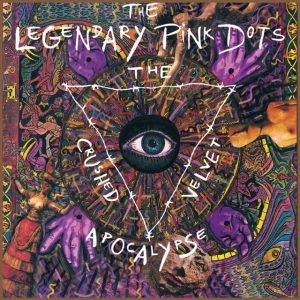
The Crushed Velvet Apocalypse (1990)
Adam: Listening to the Dots’ 1990 album The Crushed Velvet Apocalypse is many things – fascinating; disconcerting; enthralling – but one thing it is not is a pleasant experience.
The Crushed Velvet Apocalypse is also the Dots album Liz Ohanesian of LA Weekly describes as a “fan favourite”, Rich Will of Brainwashed as “perhaps … the peak of the Legendary Pink Dots’ middle-period electronic phase” and Didier Becu, writing for Peek-a-Boo Music Magazine, as the album many fans tend to pick as “the masterpiece of The Legendary Pink Dots”.
Herein lies the rub!
To understand how an album as slippery as its Czechoslovakian politics-referencing name can also be so roundly beloved, I’ll begin by trying to explain what I mean when I write that I find listening to TCVA less than pleasant and how this, in itself, may well be the irritating grit in the oyster around which the pearl of auditory pleasure inexorably forms.
Listening to TCVA is like standing with your head too close to a fog machine. As the dry ice envelops you the effect is atmospheric but asphyxiating. You may be at risk of developing a headache, becoming dizzy, or even – with tracks that extend to nearly 10 minutes – drowsy and tired.

One can imagine these machines pumping out their smoke lit by dusty fluorescent lights into already claustrophobic underground goth clubs like Soho’s ‘Batcave’, Denver’s ‘Club Onyx’ or ‘Helter Skelter’ and ‘Coven 13’ in L.A. These are the places where in the early 1990s many listeners discovered the Dots’ music on the dance-floor. Ohanesian writes that with songs like Velvet Apocalypse’s ‘Just a Lifetime’ “the Dots became staples of after-midnight playlists, not so much because the music was maudlin or overtly spooky [ed. though it often is!] but because, lyrically, it embraces the fantastical; and with its quirky time signatures and abrupt pauses, encourages dramatic motions and copious skirt-twirling on red-lit dance floors.”
Indeed, lyrically TCVA comprises a ghoul’s gallery of gristly imagery: “Drowning in dog stew and strangled in vine. Blister wine burns the inside” … “baby bones in powder piles” … “He’ll crack our backs, he’ll break our bones. His iron rod will comb the hair that stiffens on our spines” … “count the tumours on our hands” … “like knotted balls of wors rolling in the smouldering ruins of an abattoir” … “500 pounds of meat in amyl nitrate”.
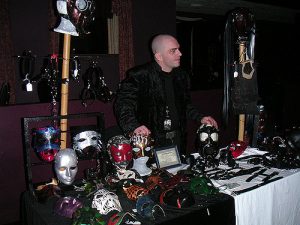
Go back some 25 years to 1993 or thereabouts, enough time for Velvet Apocalypse to be released and its single ‘Princess Coldheart’ to find its way into the clubs. Anne Rice readers, having almost waited a decade between the 1976 publication of Interview with the Vampire and the 1985 publication of The Vampire Lestat, found the ‘The Vampire Chronicles’ universe opened up to them with not only the release of The Queen of the Damned (1988) and The Tale of the Body Thief (1992), but also the three companion volumes of the ‘Lives of the Mayfair Witches’ (1990-1994). White Wolf established their lore-heavy ‘World of Darkness’ tabletop role-playing setting with ‘Vampire: The Masquerade’, ‘Werewolf: The Apocalypse’ and ‘Mage: The Ascension’, all released across the early ‘90s. Neil Gaiman’s Sandman comics series for Vertigo ran from 1989 to 1996, establishing an epic mythological universe structured around the imagery of the tarot, the Hellenic and Norse pantheons, DC comics characters, Dante’s Inferno and Shakespeare’s comedies. Meanwhile, Alan Moore’s From Hell (1989-1998) used Jack the Ripper as the metaphysical time-travelling locus point for historical change, envisioning Victorian London as an infernal melting-pot of nascent modernity, built upon ancient ley-lines, only discernible through perverse psychogeographical investigation and Gnostic speculation!
These various gothic texts all offered a world to be uncovered only by initiates. The Dots, with their shamanic stage presence, recurring characters like the tragic Astrid and the shape-shifting hermaphroditic Lily, numerological playfulness and vast back catalogue, had by 1990 already crafted a world for potential fans to lose themselves within. What is more, many of the earliest albums had been released in the tiniest of batches – Only Dreaming (1981) originally had a run of 10 copies on cassette; Brighter Now (1982) had a release of 300; Premonition (1982), just 60. By contrast, TCVA was released across the labels Play It Again Sam, Wax Trax!, Caroline, Cacciocavallo/Soleilmoon and SPV Poland concomitantly on cassette, LP and CD. What is more, 1990 also saw a re-release of Only Dreaming so new initiates could start right at the beginning of the Dots’ musical journey if they found that TVCA whet their appetites for more of Qa’Sepel’s and The Silver Man’s dark velvet visions.
And if you’d never heard the Dots before, whet your appetite TCVA certainly would. Rich Will’s comment that the album lacks “a certain cohesion that is only absent because so many other LPD records house stronger themes” and aaroneous’ claim – writing for Julian Cope’s Head Heritage – that “this one most completely encompasses their vision” both simultaneously hold true.
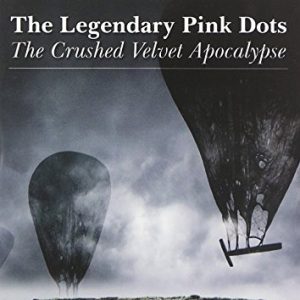
TVCA circles themes of death, damnation, stagnation, decay and rebirth via a medley of musical styles, representing in synecdoche all of the musical currents present in the Dots’ discography to that date. So, ‘I Love You in your Tragic Beauty’ recalls the psychedelic-folk of ‘Time Dance’ from 1989’s Traumstadt 5; ‘Hellsville’, the clangorous, over-layered freak-outs of Side A of Island of Jewels (1986); ‘Hellowe’en’, the creepy ambience of the various ‘Premonition’ tracks and 1982’s Basilisk; ‘The Safe Way’, bleak character pieces like ‘Space Captain No. 1’ and ‘Sensory Deprivation’ from Prayer for Aradia (1985), ‘Jewel on an Island’ or ‘The Shock of Contact’ on Island of Jewels, or ‘Soma Bath’ and ‘Phallus Dei’ way back on Only Dreaming; ‘The Death of Jack the Ripper’, the involved sound-effect assisted atmospherics of The Golden Age (1989); ‘Princess Coldheart’, gonzo fairytales like ‘The Hill’ on Asylum (1985), or my personal favourite, ‘Frosty’.
In terms of those abrasive parts of the album that rub your eardrums the wrong way… ‘I Love You in your Tragic Beauty’ is a very enticing, even pleasant opening number, with a delicate use of acoustic guitar harmonics, but things gets a lot more discordant from thereon in. Once ‘Green Gang’ has wound its way past lush reverberant valleys of chiming sitar strings (with their characteristic over-tones), babbling brooks of water and hushed hypnotic percussion issuing as though from deep jungle clearings, thousands of chattering animal voices emerge at increasing volumes and the music begins to drone and thrum, blasted with occasional stabs of TV static migraines. ‘Hellsville’ reminds me of Island of Jewels’ ‘Rattlesnake Arena’ in its sheer unrelenting density of sound – the production doesn’t even give you a moment of breathing space as Ka-Spel chants maddeningly over multi-tracked vocals of himself. The track’s harsh industrial noises and rude, parping horns of Niels Van Hoorn making his first appearance with the band, would make for terrifying music to listen to over headphones while having an MRI scan, as I once did with Radiohead’s Kid A (2000), which worked especially well with the free-jazz cacophony at the end of ‘The National Anthem’. ‘The Death of Jack the Ripper’ appropriately has lots of intriguingly dank auditory alleyways one’s imagination might slip down, perhaps inspired by Robert Bloch’ lurid gender-switched Ripper sci-fi ‘A Toy for Juliette’ from Harlan Ellison’s seminal Dangerous Visions (1967) anthology of the SF New Wave.
‘The Pleasure Palace’, meanwhile, is just plain horrible to listen to! It’s like being kicked to death in the head voluntarily at an S&M club.
It’s not just that I suspect that many new listeners of this period discovered the Dots through TCVA‘s relatively easy-going tracks like ‘Tragic Beauty’, ‘Just a Lifetime’ or the album’s single ‘Princess Coldheart’, and then, upon buying the album or the Princess Coldheart 12″, forced themselves to tackle the decidedly less palatable fare of ‘Hellsville’ or ‘The Death of Jack the Ripper’ or the ‘Coldheart’ B-sides, ‘The Pleasure Palace’ and ‘The Collector’…
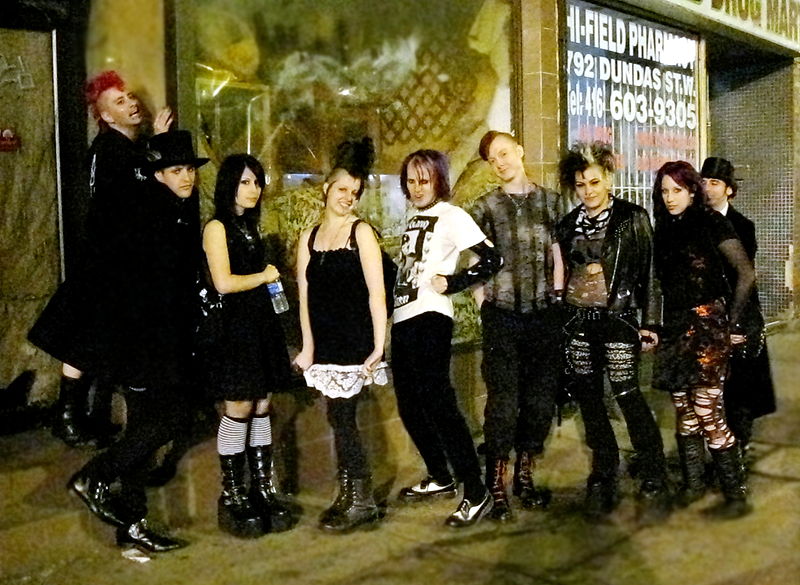
I certainly think it must have helped TVCA’s popularity that it was the first Dots album that really sounded as though it belonged to the gothic scene. The most nakedly bombastic parts of ‘Just a Lifetime’, which sound even more sterling and epic in the track’s live Crash Velvet Apocalypse incarnation – could have been penned by Rosetta Stone, Dream Theatre or Dream Disciples. The atmospheric soundscape that opens ‘Jack the Ripper’, with the sounds of treading footsteps and a muffled heartbreak, sounds to my ears similar to menacing and oh-so-gothic opening minute of Your Best Nightmare’s ‘London after Midnight’ from their 1992 debut album Selected Scenes from the End of the World – both song and album name pairing very well with the Dots’ own. And it would not altogether be an exaggeration to say that ‘The Pleasure Palace’ sounds like a track by James Ray (of The Sisterhood) played simultaneously alongside one by Midnight Configuration.
However, none of those bands were quite as willing as the Dots to let their seams show, stitching moments of musical aporia into their songs, which break the flow of the melody and jar the listener out of their revelry:
The moment at which Bob Pistoor’s (aka Father Pastorius’) screaming guitar is suddenly faded out near the end of ‘Hellsville’ so that Ka-Spel is just left chanting an imbecilic folk rhyme over his own modulated voice.
When the flamenco-style guitar and downtempo electronic chord progression of ‘New Tomorrow’ is replaced at 4:19 with hilariously inappropriate plinky-plonky noises, Van Hoorn’s sax at its most louche and lounge, and Ka-Spel chanting what sounds like “Brighter now!” (surely, the Dots’ most recurrent lyrical refrain, or else “Sing while you may!”) to a cheering fake-sounding audience.
Or else, the last quarter of ‘The Collector’, which sounds like it’s just going to be another eccentric bridge, but just continues and continues as Ka-Spel’s list of the Collector’s objects grows ever longer and more and more inscrutable and improbable… “Twenty-eight pagodas, which he shrunk with water and kept them all in a big trunk which he dug out from the sea from a huge wreck of this old galleon, and he kept galleons too, many, many galleons with skeletons and lots of treasure, and he collected them…” A riff perhaps on Jean Baudrillard’s theory in The System of Objects (1968) that a collector’s job of collecting must never be finished because it is their collection which staves off death.

Like the compulsive collector, we can’t help but return again and again to CYOA’s sore points, teasing at them, interrogating them, poking them in the hope that all will finally coalesce into some grand, holistic offering. Arguably such a totalizing vision would manifest with the following year’s The Maria Dimension (1991), which I personally find an ultimately more satisfying achievement, but not one that intrigues in the same way as The Crushed Velvet Apocalypse.
The parts of the album that hold my fascination are multiform and glimpsed in fragment. I find myself intrigued by the heart-wringing finger-style guitar around which ‘Tragic Beauty’ builds, not least because the voyeuristic lyrics seem to deliberately border upon the self-parodic, risking undercutting the sheer beauty of the music. I like that ‘Hellowe’en’ sounds like a portion from a much longer work by The Silverman a la his early piece ‘The Hands that Rock the Table’ or 2002’s haunting Requiem Settings, but never risks becoming background noise due to its sheer brevity and tension. I’m in two parts amused and disturbing by the ending of ‘Princess Coldheart’, in which the court jester becomes the willing submissive to the multi-murderess of the title and the two live happily ever after in the kind of sub-and-dom bliss that the protagonists of Any Day Now’s ‘True Love’ could only wish for. I love that Pistoor’s guitar on ‘The Collector’ sounds like Philip “Snakefinger” Lithman and that ‘The Safe Way’ could almost be a re-telling of Suicide’s ‘Frankie Teardrop’ from a more subdued, less-murderous female perspective (which is not to endorse Jordan Peterson’s evol-psych claptrap about women being inherently more agreeable, just that this is the case for Ka-Spel’s resigned protagonist).
Finally, I especially adore the fact that musically the melodic and Oriental/ist passages of TCVA – particularly the second half of the middle-bridge of ‘New Tomorrow’ – remind me of Kiss Me Kiss Me Kiss Me (1987), my favourite album by The Cure!
Ultimately then it doesn’t matter so very much that listening to The Crushed Velvet Apocalypse straight through doesn’t add up to a fully pleasurable experience for me, since as I keep picking through its ruins, I glimpse and snatch up more and more sparkling treasures which at first seemed secreted away.
As for the album’s historic importance within the goth scene…
While the Dots remain a band beloved by the few and neglected by the many, the fact that goodgoth.com sells a “Crushed Velvet Apocalypse Corset” (RSP $39.95) some 25 years after the album’s release suggests that it is an album that has lingered in the hearts of many denizens of the night long since the clubs closed down, White Wolf were bought out by Paradox Interactive, and Anne Rice became a born-again Christian.

Tom: The album opens with ‘I Love You in Your Tragic Beauty’, which is queasily exquisite, with its delicate guitar and synthetic accordion. “And that’s the way it will always be…” seems to allude back to a similar line in Any Day Now’s ‘Casting the Runes’. This song doesn’t overextend itself as several later ones do, but feels just right.
‘Green Gang’ is somewhat tiring, dank and lengthy; we find ourselves back with the ambient stylings of Four Days. There are references to Chamberlain (“peace in our time”) and also “RED ALERT!” a phrase which may also date back to WW2.

‘Hellsville’ treads the line giddily between inspired and annoying with its infuriatingly catchy chorus “Hellsville, bells peal, roll the barrel, down the pills!” This was never quite going to trouble the chart-topping likes of Sinead O’Connor, Kylie, New Order (with the best world cup song ever ‘World in Motion’), Adamski (the brilliant ‘Killer’) or the awful Timmy Mallett and Andrew Lloyd Webber combo Bombalurina.
‘Hellowe’en’ forms a brief bridge between the hyperactive goth-pop of ‘Hellsville’ to the more sedate ‘The Safe Way’, with drawn out notes and indistinct but malevolent voices.
‘The Safe Way’ starts with beguiling wistfulness, and then develops into a typically musically percolating tale of restlessness. Its subdued progress is only broken by Ka-Spel’s towering imperative “OBEY”, a melodramatic eruption.
‘Just a Lifetime’ is one of three towering tracks here and it certainly does earn its extensive duration. Beckoned in by synth harpsichord, we are then given a bounding, insistent rhythm; it’d be interesting to see the dance moves this would have elicited in its life as a Goth club floor-filler! Towards 3:00, it gets quieter, with very 1980s bass sounds. It’s then re-energised from 3:41 with thudding, stabbing percussion and guitar, and then we hurtle back into the song, with its grave yet gleefully absurd lines: “dragons walk the earth again / and paraffin was free / a fire-eater went insane and torched the final tree”. It all ends rhythm-less, with languid electric guitar; then progresses into a stately restatement of the main refrain.
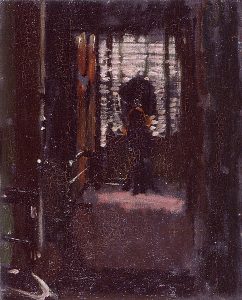
‘The Death of Jack the Ripper’, all Gothier than thou, is not really one for me – like ‘Hotel Noir’ on The Golden Age, it leaves me cold. This is bleaker and danker than that and with more markedly grotesque imagery: for example, “She could smell his fear like black piss river; like / Knotted balls of wors rolling in the smouldering / Ruins of an abattoir.”
Then is the third big highlight, the glumly glistening ‘New Tomorrow’. This song’s impact is only limited by its steady, methodical, utterly leisurely rhythm track, which lacks intensity. The languid synth tones – very 1990 – do work, alongside wind and brass instruments. This could have fitted on The Tower or Island of Jewels with its fatalistic Utopianism: “the pure and guiding light of new tomorrow”. There is the hilariously inapt plinky-plonky mid-section at 4:30; then around 5:56 you have a slow, courtly roundelay before the song finally re-emerges. The final “WE SHALL SEE OUR KINGDOM COME!” sounds all the more grimly hopeful in its 1990 context: the year of Thatcher’s fall from power, following the peaceful Velvet Revolution in Czechoslovakia in late 1989.
‘Princess Coldheart’ isn’t as arresting, other than in its grandiose “in the courtyard…” sections, which possess a decadent pomp. ‘The Pleasure Palace’ is, ironically, an example of where this record gets wearying and far from pleasurable. At eight minutes, it is palpably over-extended and headache-inducing. I can’t better Adam’s S&M simile!
‘The Collector’ is better, beginning with a belter of a Residents-style riff. This has a much more stripped back sound than most of this record. It is an absurdist tale of an obsessive collector, who has “15,934 plastic facsimiles of the Eiffel Tower, twenty percent of which were broken because they were made in Taiwan so they weren’t built to last at all”.

The closing ‘C.V.A.’ has after-echoes of earlier tracks, with hints of ‘The Safe Way’ and its languid early chords and the “peace in our time” refrain from ‘Green Gang’. Other than that, there is little to say about it.
It’s interesting to hear from Adam about just how highly rated this album is. Listened to in sequence and without knowledge of its Goth club based context, it is an often frustrating experience. Three absolutely brilliant tracks, but several more that just don’t ignite. I feel there are at least a half dozen albums that seem more impressive wholes than this one. Still, as ever with the LPDs, it is a worthwhile musical ride!